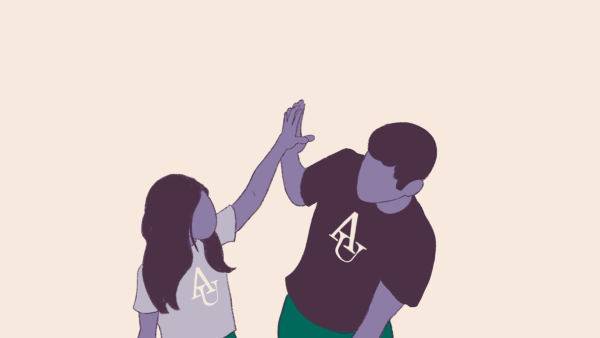No / Wonk: Advancing Universities Instead of Students
The WONK campaign is AU’s new plan to hype its “active citizenship” and prime Washington location to prospective students. It has been controversial since the beginning. The Davenport incident may seem like little more than a sophomoric prank, but it’s indicative of the opposition the WONK campaign has ignited in the AU community — and more generally, of the uncomfortable position marketing occupies in the university world.
Even 15 years ago, Flannery said, universities tended to be much more squeamish about “selling” themselves. But now universities are branding and marketing themselves like never before. To market a university, it seems, is to establish a consumer relationship; the educational, social and spiritual services a university provides are the product, and the students are the consumers. But is this “market” relationship a natural arrangement for higher education? Is it possible — or logical — to consider a university a product? What if intellectual gathering places like AU are intrinsically different from commercial purveyors of knowledge like Kaplan Test Prep or Rosetta Stone, and therefore ill-suited to attempts at “selling”?
“The American’s conception of the teacher who faces him is: he sells me his knowledge and his methods for my father’s money, just as the greengrocer sells my mother cabbage,” said German sociologist Max Weber, while addressing the University of Munich in 1918. Although he critiqued the commodification of the American higher education system, his words resonate today in the context of marketing higher education.
According to Flannery, contemporary marketers try to communicate what is distinctive about a particular college or university with the goal of increasing recruitment yields and alumni “satisfaction” – a word that tends to mean financial contributions.
The process of marketing a university is thus driven by the exchange of value that it represents: “Exchanging tuition and fees — and later on, support for the university and advocacy on its behalf — for an education and degree,” Flannery said. But how far can the metaphor of the market be taken?
Weber saw the university as qualitatively distinct from the greengrocer, and not for economic reasons. “Science,” Weber told the University of Munich, “can contribute something that the greengrocer cannot: methods of thinking, the tools and the training of thought.”
These methods of thinking may be means to an economic end, and indeed, they have practical benefits in a depressed and increasingly competitive job market. A Jan. 2010 survey of 302 employers, conducted by the Association of American Colleges and Universities, found that 81 percent of employers believe that that universities should place more emphasis on critical thinking and analytical reasoning skills.
But if a liberal university education can produce a better businessman, it does so precisely by rejecting the virtues that business rewards. In Shakespeare, Einstein, and the Bottom Line: The Marketing of Higher Education, David Kirp argues that the purpose of the university remains fundamentally at odds with the ethos of the marketplace.
He writes: “Embedded in the very idea of the university — not the storybook idea, but the university at its truest and best — are values that the market does not honor: the belief in a community of scholars and not a confederacy of self-seekers, in the idea of openness and not ownership, in the professor as a pursuer of truth and not an entrepreneur, in the student as an acolyte whose preferences are to be formed, not a consumer whose preferences are to be satisfied.”
These non-economic values are perhaps most visible to students in AU’s General Education Program. According to Dr. Patrick Jackson, the program’s director, the goal of General Education is to provide a solid foundation for both a career and a life as a generally educated person.
Highlighting the arrangement of buildings at AU, Jackson emphasizes the distinctiveness of the time, space and habits of the university experience, arguing that much of the university is deliberately constructed to be inefficient. “College,” he said, in an address to this year’s incoming University College students, “is separated out to enable a measure of clarity, of insight, of comprehensiveness that is hard to achieve in the bustle of everyday living.”
If the metaphor of the market is so ill-suited to higher education generally — and to undergraduate education at AU specifically — why market at all? According to Flannery, marketing is less about treating universities like businesses, or even selling a university education, but rather about communicating what is distinctive about a particular university.
She agrees that a university experience cannot be reduced to a simple economic transaction. “Universities exist to educate citizens who are going to be able to use their knowledge to participate in government, serve useful lives and help the world,” she said. But with over 3,000 institutions of higher learning in the United States — and many more abroad – seeking to do more or less exactly that, she claims that marketing’s role is to enable students to distinguish among their myriad choices.
Flannery differentiates between marketing for a university and marketing for a business. “Higher education has much greater expectations from within the community for being informed and participating in the brand,” she said. “You never would have seen the amount of time and number of people we included in the WONK campaign in a corporate setting.”
This level of inclusion was necessary to determine AU’s identity, Flannery said. But as the altered mugs suggest, not everyone on campus identifies with the WONK brand. Members of the AU community have expressed their discontent in blog posts and in online comments on coverage of the campaign by The Eagle and the Washington Post.
Students have pointed out the derogatory meanings of the word “wonk,” criticized its connotation of narrow specialization, and questioned the university’s $675,000 tab for the marketing campaign.
But University Communications and Marketing is unfazed by these objections. For a campaign like WONK to be successful, Flannery said, you just need a critical mass who like it, even if most of the community has lukewarm or oppositional feelings toward it.
As far as UCM is concerned, the real indicators of the campaign’s succcess will be an improvement in the ratio of students who choose AU compared to students recruited, and in alumni satisfaction. A few cleverly altered mugs and some outraged online comments are unlikely to undermine or change the campaign in any substantive way, because they will not move the key dials that UCM monitors. Community input may have been important during planning, but in the economic context of marketing, numbers are decisive.
Quantifiable metrics are well-suited to the mathematized world of business and economics, and good indicators of AU’s prestige and financial health. They have little impact, however, on the academic experience of current AU students. College life is thus subordinated to the selling of college life.
Max Weber was a persistent advocate of education as process of personal discovery, not just a means to advance economic status. Weber probably wouldn’t have scratched letters off a coffee mug, but he likely would have admired the sentiment behind the NO/WONK mugs. NO/WONK challenges the idea that universities are part of a commoditized world governed by the supremacy of market forces. It is a challenge that really only makes sense in the context of a liberal university education. AU may well be succeeding in spite of itself.
Photo by Amberley Romo.












